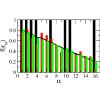当前位置:
X-MOL 学术
›
Phys. Rev. E
›
论文详情
Our official English website, www.x-mol.net, welcomes your
feedback! (Note: you will need to create a separate account there.)
Eigenstate thermalization and ensemble equivalence in few-body fermionic systems.
Physical Review E ( IF 2.2 ) Pub Date : 2020-06-25 , DOI: 10.1103/physreve.101.062141 Ph Jacquod 1
Physical Review E ( IF 2.2 ) Pub Date : 2020-06-25 , DOI: 10.1103/physreve.101.062141 Ph Jacquod 1
Affiliation

|
We investigate eigenstate thermalization from the point of view of vanishing particle and heat currents between a few-body fermionic Hamiltonian prepared in one of its eigenstates and an external, weakly coupled Fermi-Dirac gas. The latter acts as a thermometric probe, with its temperature and chemical potential set so that there is neither particle nor heat current between the two subsystems. We argue that the probe temperature can be attributed to the few-fermion eigenstate in the sense that (i) it varies smoothly with energy from eigenstate to eigenstate, (ii) it is equal to the temperature obtained from a thermodynamic relation in a wide energy range, (iii) it is independent of details of the coupling between the two systems in a finite parameter range, (iv) it satisfies the transitivity condition underlying the zeroth law of thermodynamics, and (v) it is consistent with Carnot's theorem. For the spinless fermion model considered here, these conditions are essentially independent of the interaction strength. When the latter is weak, however, orbital occupancies in the few-fermion system differ from the Fermi-Dirac distribution so that partial currents from or to the probe will eventually change its state. We find that (vi) above a certain critical interaction strength, orbital occupancies become close to the Fermi-Dirac distribution, leading to a true equilibrium between the few-fermion system and the probe. In that case, the coupling between the Fermi-Dirac gas and few-fermion system does not modify the state of the latter, which justifies our approach a posteriori. From these results, we conjecture that for few-body systems with sufficiently strong interaction, the eigenstate thermalization hypothesis is complemented by ensemble equivalence: individual many-body eigenstates define a microcanonical ensemble that is equivalent to a canonical ensemble with grand canonical orbital occupancies.
中文翻译:

少体费米电子系统中的本征态热化和集合等价。
我们从消失的角度研究本征态热化,这些微粒和热流是在一种本征态中制备的几体费米尔顿哈密顿量与外部弱耦合费米-狄拉克气体之间的。后者用作测温探针,其温度和化学势被设定为在两个子系统之间既没有粒子也没有热电流。我们认为探针温度可以归因于以下几个方面:(i)它随能量从本征态到本征态而平稳地变化;(ii)等于从宽能量的热力学关系获得的温度(iii)在有限参数范围内与两个系统之间的耦合细节无关,(iv)满足热力学零定律的传递条件,(v)与卡诺定理一致。对于此处考虑的无刺费米子模型,这些条件基本上与相互作用强度无关。但是,当后者较弱时,少数费米子系统中的轨道占有率与费米-狄拉克分布不同,因此从或流向探测器的部分电流最终将改变其状态。我们发现(vi)在一定的临界相互作用强度以上,轨道占有率变得接近费米-狄拉克分布,从而导致少数费米子系统与探测器之间达到真正的平衡。在那种情况下,费米-狄拉克气体和稀有费米子系统之间的耦合不会改变后者的状态,这证明了我们的方法是正确的 这些条件基本上与相互作用强度无关。但是,当后者较弱时,少数费米子系统中的轨道占有率与费米-狄拉克分布不同,因此从或流向探测器的部分电流最终将改变其状态。我们发现(vi)在一定的临界相互作用强度以上,轨道占有率变得接近费米-狄拉克分布,从而导致少数费米子系统与探测器之间达到真正的平衡。在那种情况下,费米-狄拉克气体和稀有费米子系统之间的耦合不会改变后者的状态,这证明了我们的方法是正确的 这些条件基本上与相互作用强度无关。但是,当后者较弱时,少数费米子系统中的轨道占有率与费米-狄拉克分布不同,因此从或流向探测器的部分电流最终将改变其状态。我们发现(vi)在一定的临界相互作用强度以上,轨道占有率变得接近费米-狄拉克分布,从而导致少数费米子系统与探测器之间达到真正的平衡。在那种情况下,费米-狄拉克气体和稀有费米子系统之间的耦合不会改变后者的状态,这证明了我们的方法是正确的 少数费米子系统中的轨道占有率不同于费米-狄拉克分布,因此从或流向探测器的部分电流最终将改变其状态。我们发现(vi)在一定的临界相互作用强度以上,轨道占有率变得接近费米-狄拉克分布,从而导致少数费米子系统与探测器之间达到真正的平衡。在那种情况下,费米-狄拉克气体和稀有费米子系统之间的耦合不会改变后者的状态,这证明了我们的方法是正确的 少数费米子系统中的轨道占有率不同于费米-狄拉克分布,因此从或流向探测器的部分电流最终将改变其状态。我们发现(vi)在一定的临界相互作用强度以上,轨道占有率变得接近费米-狄拉克分布,从而导致少数费米子系统与探测器之间达到真正的平衡。在那种情况下,费米-狄拉克气体和稀有费米子系统之间的耦合不会改变后者的状态,这证明了我们的方法是正确的后验。从这些结果中,我们推测对于具有足够强相互作用的少数体系统,本征态热化假设与整体等效性相辅相成:单个多体本征态定义了一个微正则整体,它等同于具有大正则轨道占有率的典型整体。
更新日期:2020-06-25
中文翻译:

少体费米电子系统中的本征态热化和集合等价。
我们从消失的角度研究本征态热化,这些微粒和热流是在一种本征态中制备的几体费米尔顿哈密顿量与外部弱耦合费米-狄拉克气体之间的。后者用作测温探针,其温度和化学势被设定为在两个子系统之间既没有粒子也没有热电流。我们认为探针温度可以归因于以下几个方面:(i)它随能量从本征态到本征态而平稳地变化;(ii)等于从宽能量的热力学关系获得的温度(iii)在有限参数范围内与两个系统之间的耦合细节无关,(iv)满足热力学零定律的传递条件,(v)与卡诺定理一致。对于此处考虑的无刺费米子模型,这些条件基本上与相互作用强度无关。但是,当后者较弱时,少数费米子系统中的轨道占有率与费米-狄拉克分布不同,因此从或流向探测器的部分电流最终将改变其状态。我们发现(vi)在一定的临界相互作用强度以上,轨道占有率变得接近费米-狄拉克分布,从而导致少数费米子系统与探测器之间达到真正的平衡。在那种情况下,费米-狄拉克气体和稀有费米子系统之间的耦合不会改变后者的状态,这证明了我们的方法是正确的 这些条件基本上与相互作用强度无关。但是,当后者较弱时,少数费米子系统中的轨道占有率与费米-狄拉克分布不同,因此从或流向探测器的部分电流最终将改变其状态。我们发现(vi)在一定的临界相互作用强度以上,轨道占有率变得接近费米-狄拉克分布,从而导致少数费米子系统与探测器之间达到真正的平衡。在那种情况下,费米-狄拉克气体和稀有费米子系统之间的耦合不会改变后者的状态,这证明了我们的方法是正确的 这些条件基本上与相互作用强度无关。但是,当后者较弱时,少数费米子系统中的轨道占有率与费米-狄拉克分布不同,因此从或流向探测器的部分电流最终将改变其状态。我们发现(vi)在一定的临界相互作用强度以上,轨道占有率变得接近费米-狄拉克分布,从而导致少数费米子系统与探测器之间达到真正的平衡。在那种情况下,费米-狄拉克气体和稀有费米子系统之间的耦合不会改变后者的状态,这证明了我们的方法是正确的 少数费米子系统中的轨道占有率不同于费米-狄拉克分布,因此从或流向探测器的部分电流最终将改变其状态。我们发现(vi)在一定的临界相互作用强度以上,轨道占有率变得接近费米-狄拉克分布,从而导致少数费米子系统与探测器之间达到真正的平衡。在那种情况下,费米-狄拉克气体和稀有费米子系统之间的耦合不会改变后者的状态,这证明了我们的方法是正确的 少数费米子系统中的轨道占有率不同于费米-狄拉克分布,因此从或流向探测器的部分电流最终将改变其状态。我们发现(vi)在一定的临界相互作用强度以上,轨道占有率变得接近费米-狄拉克分布,从而导致少数费米子系统与探测器之间达到真正的平衡。在那种情况下,费米-狄拉克气体和稀有费米子系统之间的耦合不会改变后者的状态,这证明了我们的方法是正确的后验。从这些结果中,我们推测对于具有足够强相互作用的少数体系统,本征态热化假设与整体等效性相辅相成:单个多体本征态定义了一个微正则整体,它等同于具有大正则轨道占有率的典型整体。











































 京公网安备 11010802027423号
京公网安备 11010802027423号